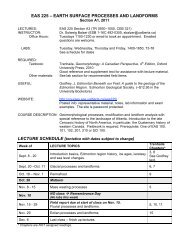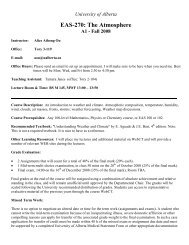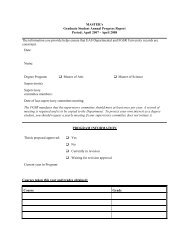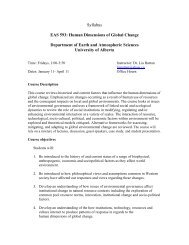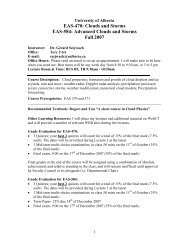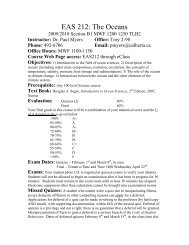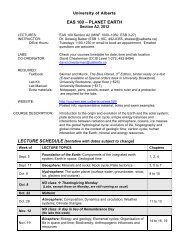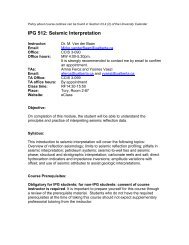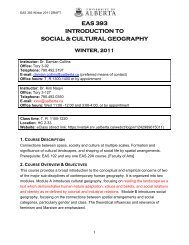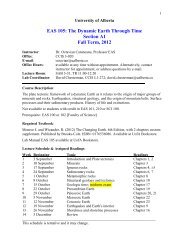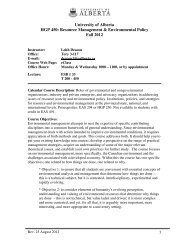Stratigraphy and Sedimentary Basins - Earth and Atmospheric ...
Stratigraphy and Sedimentary Basins - Earth and Atmospheric ...
Stratigraphy and Sedimentary Basins - Earth and Atmospheric ...
Create successful ePaper yourself
Turn your PDF publications into a flip-book with our unique Google optimized e-Paper software.
EAS 462/562 – 2009, Winter Term (3-0-3):<strong>Stratigraphy</strong> <strong>and</strong> <strong>Sedimentary</strong> <strong>Basins</strong>Instructor: Dr. Octavian Catuneanu Office: HMT (Tory) 3-117Department of <strong>Earth</strong> <strong>and</strong> <strong>Atmospheric</strong> Sciences Phone: (780) 492-6569University of AlbertaE-mail: octavian@ualberta.caOffice hours: contact instructor for appointment.Course description:The science of rock strata in a sequence stratigraphic framework; sequence stratigraphic models;classification <strong>and</strong> evolution of sedimentary basins; applications of sequence stratigraphy to depositionalsystems <strong>and</strong> tectonic settings.Not available to students with credit in EAS 330 [Faculty of Science]Required textbook (available at the U of A Bookstore):Catuneanu, O. (2006) Principles of Sequence <strong>Stratigraphy</strong>. Elsevier, 375 pp.Recommended textbooks:Miall, A.D. (2000) Principles of <strong>Sedimentary</strong> Basin Analysis. Third edition, Springer, 616 pp.Busby, C.J. <strong>and</strong> Ingersoll, R.V. (1995) Tectonics of <strong>Sedimentary</strong> <strong>Basins</strong>. Blackwell, 579 pp.Einsele, G. (1992) <strong>Sedimentary</strong> <strong>Basins</strong> - Evolution, Facies, <strong>and</strong> <strong>Sedimentary</strong> Budget. Springer, 628 pp.Allen, P.A. <strong>and</strong> Allen, J.R. (1990) Basin Analysis - Principles <strong>and</strong> Applications. Blackwell, 451 pp.Course evaluation:1. Lab project: 30% of final mark.• Topic: case study of sequence stratigraphic interpretation.• Approach:- independent research, flexible hours (3 hours per week are credited towards this project)- choose one case study, based on published outcrop, core, well-log or seismic data- define the study area <strong>and</strong> the stratigraphic objective- define the type(s) of data available <strong>and</strong> the purpose of the project- present the uninterpreted data (e.g., outcrop sections, well-log cross-sections or seismic lines)- present the interpreted data (e.g., cross-sections <strong>and</strong> maps of any kind)1
- paper size: ‘letter’ or ‘tabloid’- submit: one hard copy of your project (maximum 5 pages of single-spaced text + illustrations <strong>and</strong>references) <strong>and</strong> a PPT file with the illustrations (include a caption <strong>and</strong> reference in the footnote ofeach slide)• Deadline: 8 April 2009 (last day of classes).2. In-class presentation: 25% of final mark.• Topic: exercise of sequence stratigraphic interpretation.• Approach:- choose one key cross-section or seismic line from your lab project- prepare: one-page h<strong>and</strong>out (text), to present the data <strong>and</strong> the purpose of the exercise- present the uninterpreted data (i.e., cross-section or seismic line)- present the interpreted data (i.e., the solution to the exercise)- be prepared to defend the interpretation- submit: one hard copy <strong>and</strong> one electronic copy (PPT) of your exercise- NB: examples of such exercises will be presented in class by instructor• Time limit: 20 minutes, followed by 5 minutes of questions <strong>and</strong> discussions• Deadline: 1 March 2009. Be prepared to present anytime after this deadline.3. Final essay: 45% of final mark.• Topic: applications of sequence stratigraphy to tectonic settings (2).• Approach:- choose a tectonic setting from the list below- present the main characteristics of that particular tectonic setting: physiography, scale, subsidencemechanisms, depositional systems <strong>and</strong> sediment supply- present at least three case studies to illustrate the application of sequence stratigraphy to thatparticular tectonic setting, preferably involving different depositional systems- based on the case studies presented, summarize the sequence stratigraphic architecture (or“model”) that typifies that particular tectonic setting (e.g., typical geometries; relative developmentof systems tracts; what systems tracts, depositional systems <strong>and</strong> sequence stratigraphic surfacestend to be most prominent, etc.)- submit: one hard copy of your final essay (maximum 20 pages of single-spaced text + illustrations<strong>and</strong> references), <strong>and</strong> a PPT file with the illustrations (include a caption <strong>and</strong> reference in thefootnote of each slide)• Deadline: 25 April 2009 (last day of examinations).Tectonic settings:1. Intracratonic basins2. Grabens3. Rift basins4. Divergent continental margins: continental shelves5. Divergent continental margins: slope-basin floor settings6. Convergent margins: deep-sea trenches <strong>and</strong> accretionary prisms2
7. Convergent margins: forearc basins8. Convergent margins: backarc basins (active)9. Convergent margins: interarc basins (inactive)10. Convergent margins: retroarc forel<strong>and</strong>s11. Convergent margins: proarc forel<strong>and</strong>s12. Convergent margins: intramontane basins13. Transform margins: strike-slip basinsTeaching assistant:Ryan King , Tory 3-9.3



